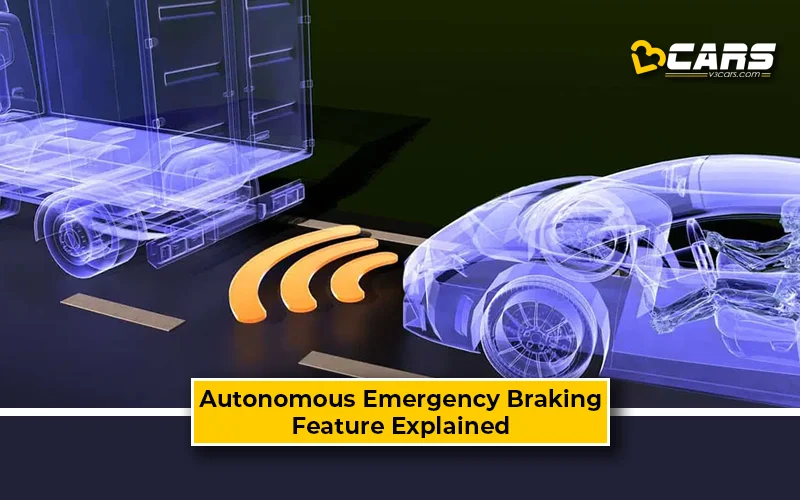Autonomous Emergency Braking (AEB) – ADAS Feature Explained
Autonomous Emergency Braking, or AEB, is a crucial ADAS feature found in most modern cars. It stands as one of the most significant advancements in automotive safety technology. This intelligent system acts as a safety net, capable of intervening automatically to prevent collisions when a driver fails to react in time. Let’s explore what AEB is, how it works, its various types, and its profound benefits.

What Is Autonomous Emergency Braking (AEB)?
Autonomous Emergency Braking (AEB) is an advanced driver-assistance system (ADAS) that is designed to automatically apply the brakes of a car if it detects an imminent collision and the driver does not respond adequately. Its primary goal is to either avoid a crash entirely at lower speeds or significantly reduce the impact severity at higher speeds, thereby minimising injuries and damage.
How Does Autonomous Emergency Braking Work?
AEB systems function through a combination of sensors and a control unit:
Sensor Input: AEB systems rely on various forward-looking sensors, which can include:
- Radar: Excellent for detecting objects and their distance/speed, even in adverse weather.
- Lidar: Provides precise object recognition.
- Cameras: Crucial for identifying object types (vehicles, pedestrians, cyclists) and interpreting road signs.
- Ultrasonic Sensors: Used for very short-range detection, often in low-speed or parking scenarios.
Continuous Monitoring: These sensors continuously scan the road ahead, monitoring traffic, obstacles, and vulnerable road users (pedestrians, cyclists).
Risk Assessment: An electronic control unit (ECU) processes the sensor data in real-time. It uses complex algorithms to calculate the risk of a collision based on factors like the vehicle’s speed, the distance to the obstacle, and the predicted trajectory.
Driver Alert: If a potential collision is detected, the AEB system typically provides initial warnings to the driver. These are often multi-sensory, including visual alerts (flashing lights on the dashboard or windshield), audible alarms (beeps or chimes), and sometimes haptic feedback (vibrations in the steering wheel or seat). This is usually the first stage, part of a Forward Collision Warning (FCW) system, which precedes full AEB intervention.
Automatic Braking Intervention: If the driver does not react to the warnings, or if a collision is deemed unavoidable, the AEB system takes over. It autonomously applies the car’s brakes with sufficient force to either bring it to a complete stop (at lower speeds) or significantly reduce its speed before impact. The system can also enhance the driver’s own braking if it detects insufficient pressure.
Also Read: Forward Collision Warning (FCW) – Feature Explained
What Are The Different Types Of Autonomous Emergency Braking?
AEB systems are evolving and can be categorised based on their detection capabilities and operating speeds:
- Forward AEB (Vehicle Detection): The most common type, primarily designed to detect and react to other vehicles (moving or stationary) in the path ahead.
- Forward AEB with Pedestrian/Cyclist Detection: More advanced systems that can also recognise and react to pedestrians, cyclists and sometimes large animals entering the car’s path.
- Low-Speed AEB (City AEB): Optimised for urban driving and congested traffic, typically operating at speeds below 30-40kmph. Effective in preventing minor fender-benders.
- High-Speed AEB (Inter-Urban AEB): Designed to prevent or mitigate more serious collisions on highways or rural roads, operating at higher speeds.
- Intersection AEB (Junction AEB): Newer systems that can detect crossing vehicles or pedestrians when the car is turning at an intersection and automatically brake if a collision is imminent.
- Reverse AEB: Detects obstacles behind the car when reversing and can automatically apply brakes to prevent a collision. This system often works with rear cross-traffic alert systems.
What Are The Pros And Cons Of Autonomous Emergency Braking (AEB)?
Here are the pros of autonomous emergency braking:
- Accident Prevention: AEB is effective at preventing collisions, especially rear-end crashes and low-speed urban impacts.
- Reduced Injury Severity: Even if a collision cannot be avoided, AEB significantly reduces the impact speed, leading to less severe injuries for occupants and less vehicle damage.
- Faster Reaction Time: The system reacts much faster than a human driver in emergency situations, saving milliseconds in reaction time.
- Enhanced Road Safety: By preventing and mitigating collisions, AEB contributes significantly to overall road safety for all users.
- Works Day And Night: Modern systems are designed to operate effectively in various lighting conditions.
Here are the cons of autonomous emergency braking:
- Potential For False Positives: In rare instances, the system might misinterpret objects (shadows, metal signs, vehicles in adjacent lanes on curves) and apply brakes unnecessarily, which can be startling for the driver.
- Sensor Limitations: Performance can be affected by adverse weather (heavy rain, snow, dense fog) or sensor obstruction (dirt, ice).
- Not A Substitute For Driver Attention: AEB is an assistance system and does not replace the driver’s responsibility to remain alert and attentive to road conditions. Over-reliance on ADAS can be dangerous.
- Added Vehicle Cost: AEB is a sophisticated technology that adds to the overall purchase price of a car as they are typically offered as part of an ADAS suite.
Can Autonomous Emergency Braking (AEB) Be Installed From The Aftermarket?
Installing a full-fledged AEB system from the aftermarket is extremely complex and generally not recommended.
- Deep Integration Required: AEB requires seamless integration with the car’s braking system, engine control unit (ECU), traction control (TCS), electronic stability control (ESC), and various sensors (radar, camera, lidar). Replicating this level of integration reliably in the aftermarket is exceptionally difficult.
- Calibration Challenges: Precise calibration of the sensors and software is vital for AEB to function correctly and safely. Aftermarket solutions may struggle to achieve OEM-level calibration.
- Safety and Legal Risks: Improper installation could lead to system malfunctions, false positives (unintended braking), or failure to activate when needed, creating serious safety hazards. It could also have legal and warranty implications.
Affordable Cars In India That Offer Autonomous Emergency Braking (AEB)?
AEB is becoming increasingly available in mass market cars sold in India, often as part of Level 2 ADAS suites. Here are some affordable cars in India (higher variants) that offer AEB as of mid-2025:
- Mahindra XUV 3XO
- Honda Amaze
- Honda City
- Kia Sonet
- Hyundai Creta
- Mahindra Scorpio-N
- Tata Harrier EV
- Tata Curvv EV
Also Read: Hill Descent Control – Feature Explained
Helpful Tools:
- Fuel Cost Calculator for Cars – Know your monthly fuel expense based on usage and mileage
- Car On-Road Price Calculator – Convert ex-showroom to on-road price for any city
Sell Used Car Online – Enter your car and contact details to get an instant price estimate and book a free inspection with our partner network


0 Comments